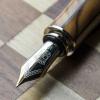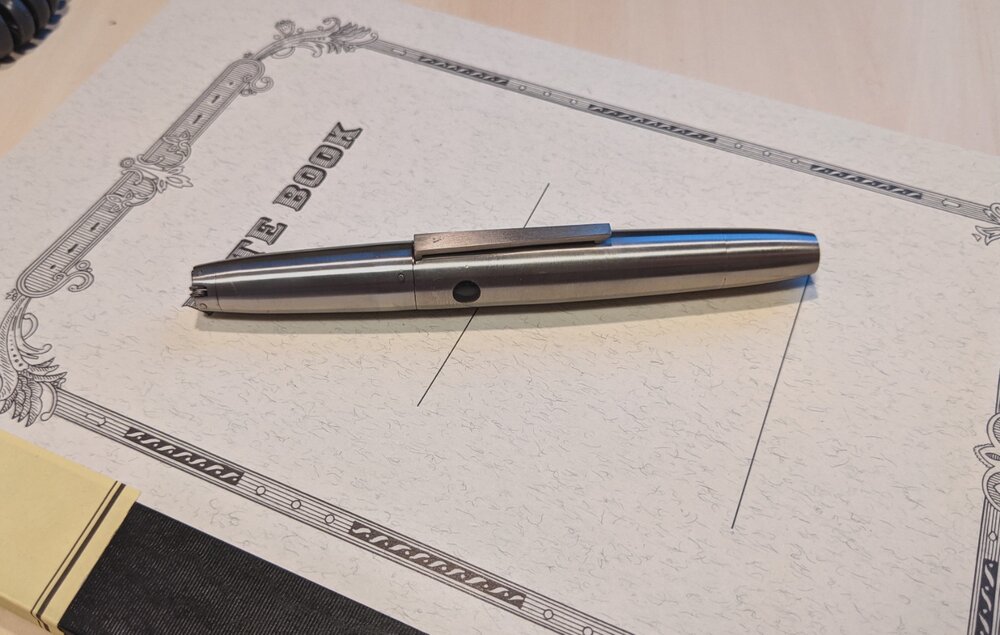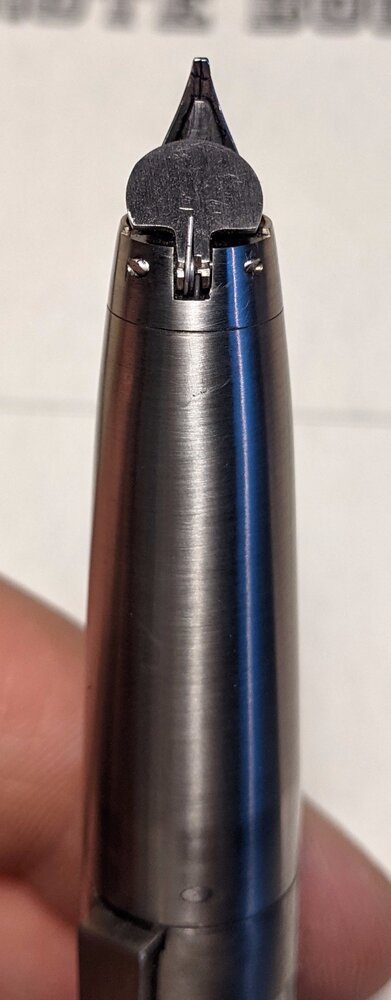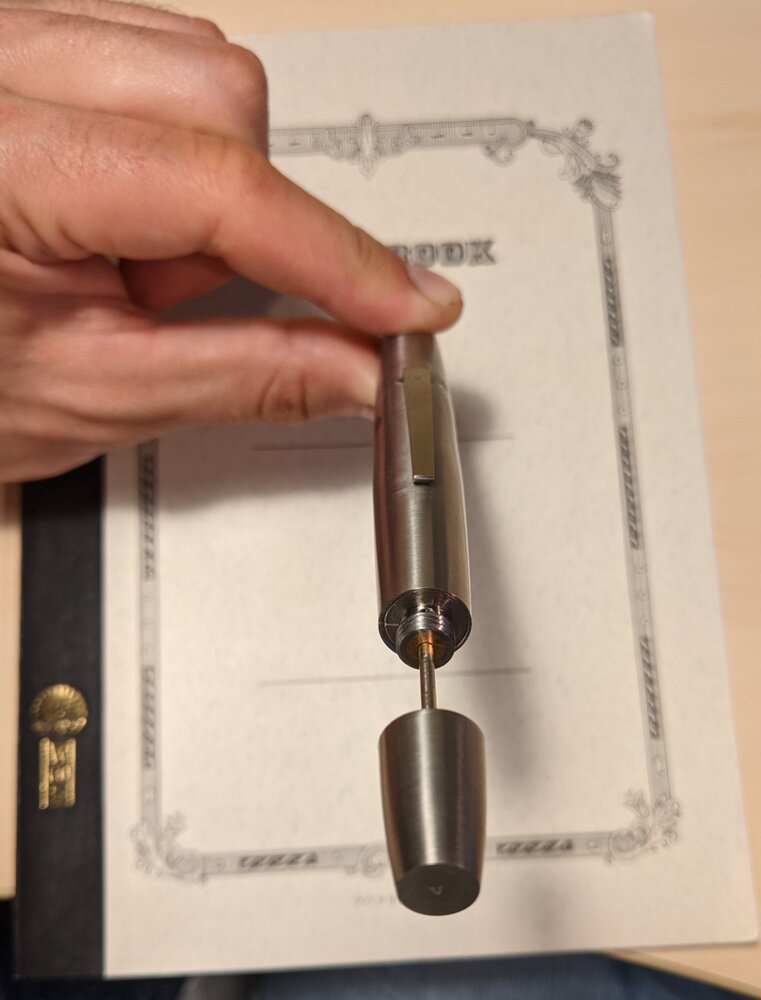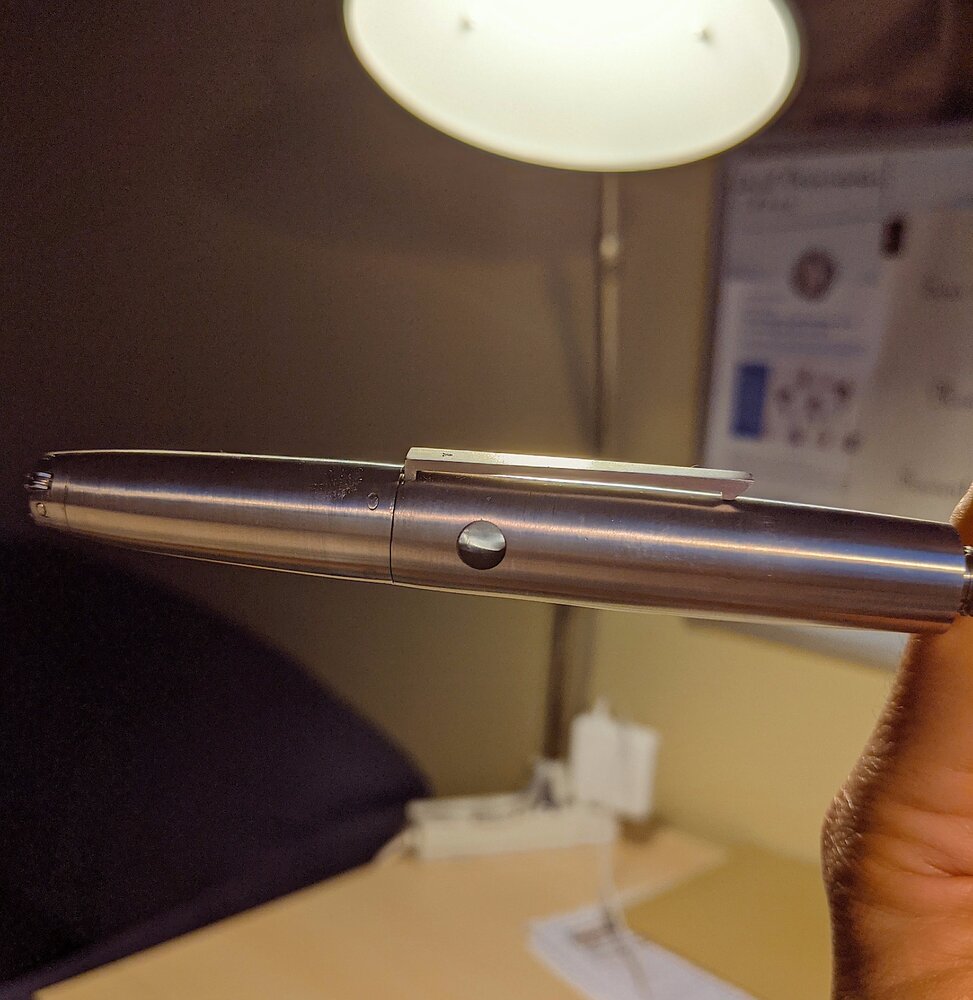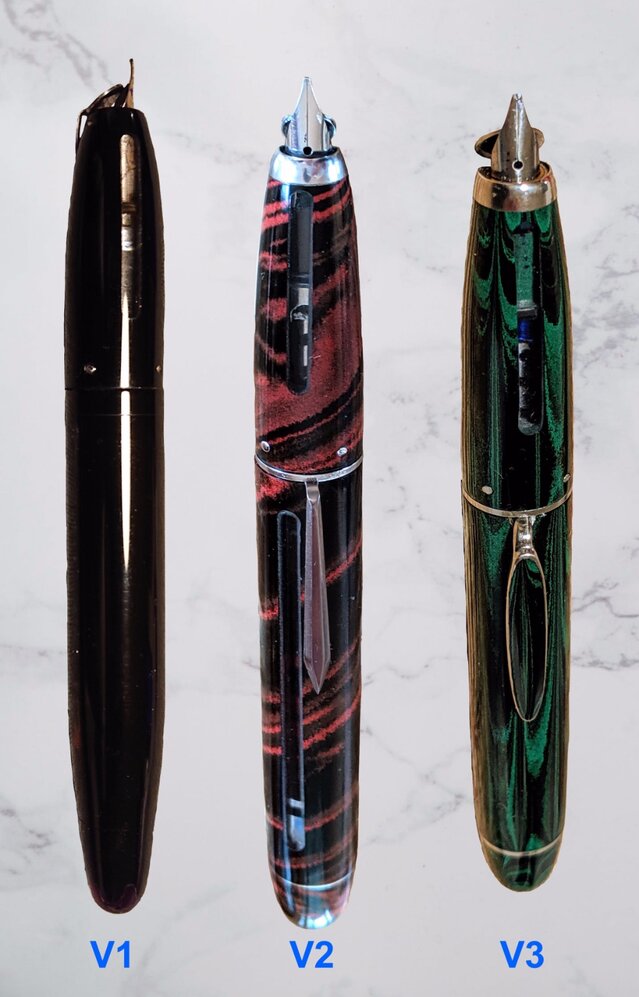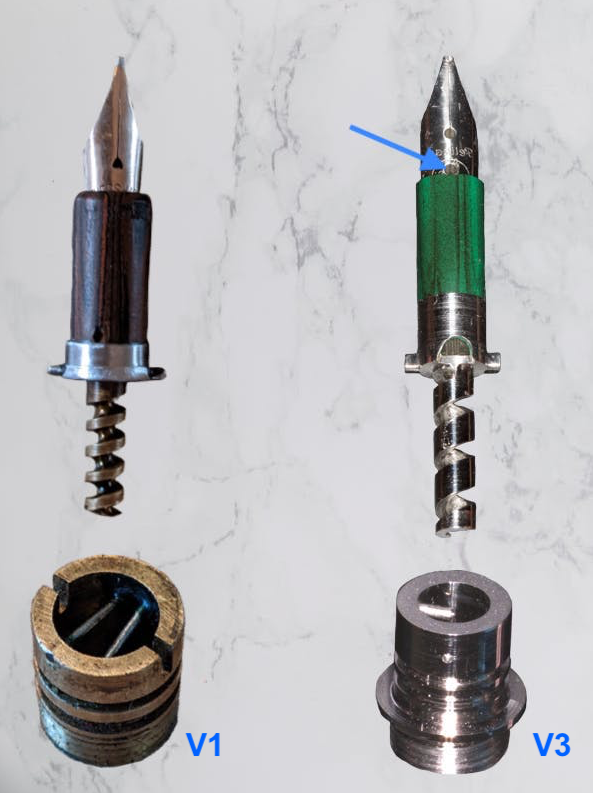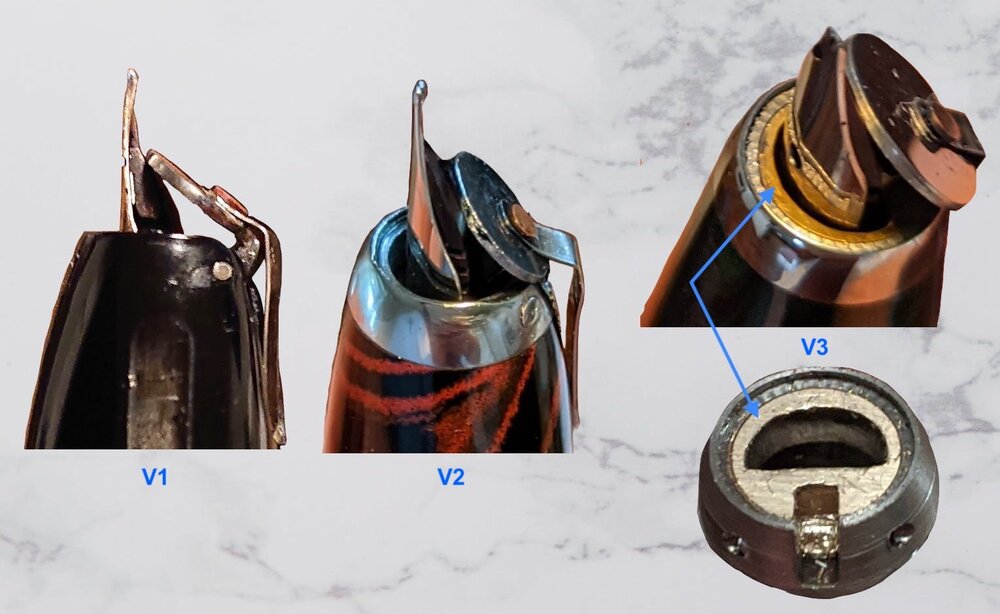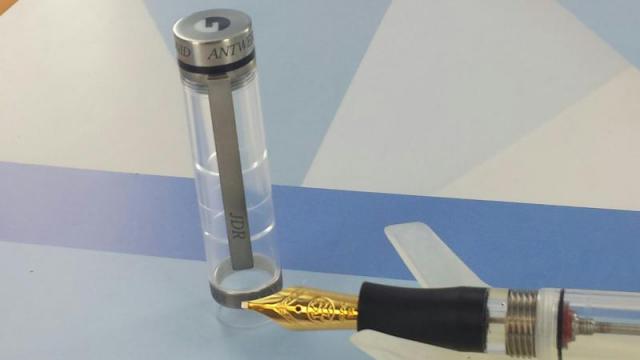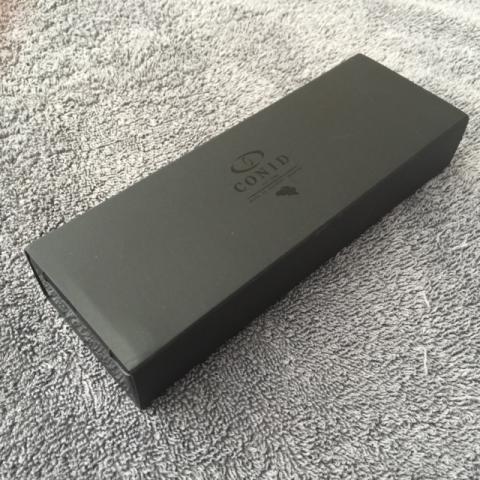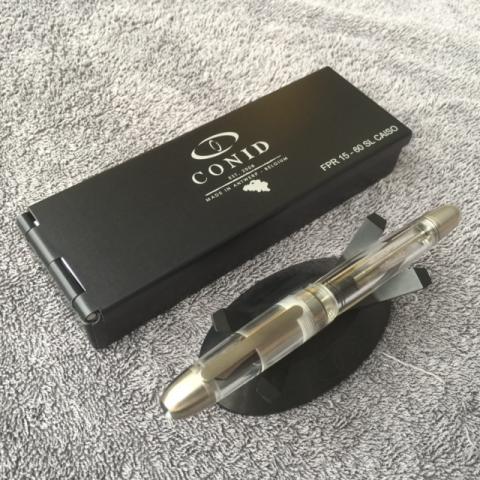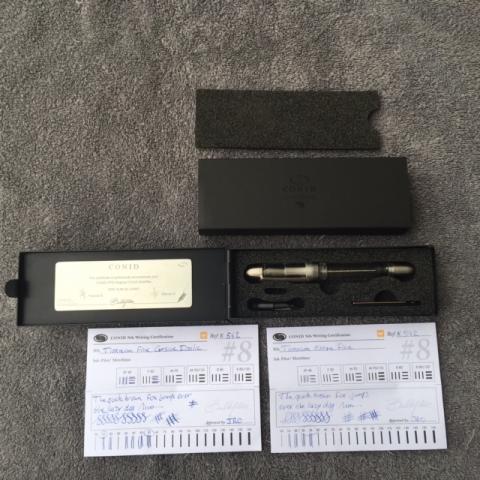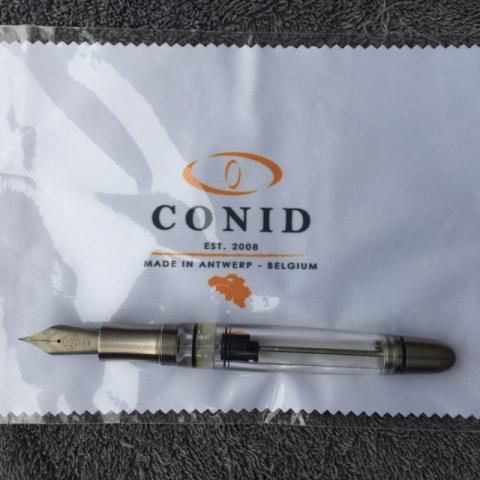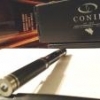Search the Community
Showing results for tags 'bulkfiller'.
-
PRELUDE An Intrigue with Scarcity Marketing There are some days in life when scarcity marketing absolutely triumphs over our emotions, and this was one of those days where all my rationality seemed to take 'another' toss. As for me, with a career in quants & finance, I have a compulsive inclination to divide anything and everything by the number of users and then by 12 months to arrive at a per-user price metric. But pens, they're poetry to me, and they defy such quantification. I already own a Kingsize with a 14k nib, which I acquired precisely after a 9-month wait in 2020 — no joke. Yet, somehow, the allure of Conid's bulkfiller mechanism with titanium finials, coupled with the temptation of a #6 Ti nib, proved difficult to resist. Then, as fate would have it, the rather modest news section of Conid was updated with this new offering. And honestly, my belief that the Minimalistica surpasses the Regular model in terms of both weight balance and the comfort of its seemingly infinite curvature of the section is grounded in my own experience, as my relatively longer fingers find resting spots almost everywhere along its dimensions. May be more on that later. I acquired a Regular model (the last piece of the AntwerPPen edition) from the gracious Mr. Yves (of Penworld) during my recent visit to San Francisco this month. PS. By the way, if you somehow you managed to overlook the purple rain KS, congratulations are in order because you've just dodged a whopping 1100 EUR bullet If you like a pictorial blogger view, here is a link: A Review of the Conid Minimalistica PRESENTATION (6/6) Love to the Cobox It seems pretty standard for Conid, and I love their engineered box. I would never toss this box into the bin; the first reason, of course, is the whopping price I paid for the pen, and the second reason is that the box is well-designed and pretty lightweight, given it’s made from aluminium sheet. The newer ones carry Penworld logo on the base. I haven't tested their susceptibility to being malleable enough to be bent, but the anodisation does prevent it from getting scratched. Upon opening the box, you'll find a bulkfiller certificate embossed on a silver metal plate on the inside of the lid, along with an instruction manual, a nib testing certificate, and a few extra O-rings. Inside the main compartment, you'll find the foam cut to specific compartments to house a disassembly wrench, an Allen key, and a slot to accommodate a spare nib unit. I do have the tools that came with the Kingsize. DESIGN (5/6) Functionalism The Minimalistica, previously available in five main finishes, is now offered as a limited run product with the most common nib materials and widths (with a promise of permanent availability for select finishes). In fact, all Conid pens are now more or less limited runs. The finials and ends have been permutations of derlin, ebonite, and titanium. The one I acquired is labeled M-DCB-DB-TI, meaning Minimalistica - Demonstrator Conid Bulkfiller - Demonstrator Barrel - Titanium knobs. There's no "+" sign at the end, but I did opt for it with a clip. Here's a link to assist you when your brain gives out! To be frank, the pen's shape isn't particularly attractive. It's not one of those love-at-first-sight designs, like a Yukari Royale! It's simply a cylinder with tapered ends. However, the functional beauty of it becomes apparent when you actually hold the pen. Additionally, the derlin part of the cap in a demonstrator barrel makes it appear even less appealing when it's not filled with ink. The beauty of the pen truly shines as you uncap it. However, this is where I encountered a learning curve. Here's where my -1 penalty for non-intuitive functionality design comes into play, with zero hints provided in the manual. The cap is secured to the barrel by an o-ring placed almost halfway along its length. Initially, I attempted to pull it off like a snap cap, only to find ink spilling onto the table, paper, or anything within nib's reach. It was later that I discovered the proper method of uncapping it, using a slight twist and pull technique similar to what Johan (JRO) demonstrates while changing the nib in this video. Mastering the uncapping process took some time. Additionally, the nib wasn't properly inserted into the housing at first, causing the pen to leak ink onto whatever surface it could find. The cap is adorned with the iconic Conid hook emblem, a familiar sight on most Conid pens. Both the finial and the clip of this pen are crafted from titanium, boasting a finish that seems to match the grade 5 titanium used in the Apple Watch Ultra. While I can't confirm if Conid employs the exact same grade, it's certainly a strong possibility. As for the black derlin portion, well, it's not exactly my favorite, but I can tolerate it. Strangely enough, the black derlin adds a certain continuity to the cap, only to be disrupted by the transparent barrel, when un-inked. There's a sense of understated elegance rather than outright luster to the metal parts. Upon closer inspection, you'll notice the now infamous o-ring nestled inside, which secures the cap in place. While searching for different grades of titanium, I stumbled upon some intriguing facts. Grade 5 titanium, also known as Ti-6Al-4V (which translates to 6% Aluminium & 4% Vanadium), is commonly used in implants to mimic bone-like structures. On the other hand, grade 9 titanium (Ti-3Al-2.5V) finds its home in applications requiring higher precision, including pacemakers. FILLING & CLEANING SYSTEMS (6/6) Bulkfiller breathes its magic, double reservoir maintains the flow I believe this is where this pen sets itself apart. While there are certainly cheaper Chinese alternatives and a rather well-made upmarket Kyuseido Kakari that, I must admit, looks better than this Minimalistica with its #6 nib with variations of syringe-filling mechanisms. Personally, I find filling this pen to capacity quite satisfying, although it's more about contentment than any significant difference for me compared to the capacity of vacuum-filled pens like the Visconti Homo Sapiens or the Pilot Custom 823. Once you unscrew the piston knob, it will initially open the seal of the secondary reservoir, designed for extended writing sessions. To fill ink, you pull out the piston rod (after unscrewing it) and engage the rod with the locking mechanism of the piston seal by further rotating it counter-clockwise. Once the piston seal is disengaged, the pen behaves like a syringe. First, you push it down to expel the air, and then draw ink into the barrel by submerging the nib in an ink bottle and pulling the piston seal up. Then, you lock the piston seal onto the end using the locking mechanism. Next, you rotate the piston rod clockwise to disengage it from the piston seal and push it down to seal the secondary reservoir. Johan's video does a much better job of explaining this process. It takes a few tries to get used to the filling system. Furthermore, the double reservoir design functions exceptionally well. It endured four long-haul flights without a single drop of ink leaking from the nib. For comparison, an Asvine P36 equipped with a Sailor nib leaked a drop, perhaps two. By the way here is the patent application for Conid’s locking mechanism. NIB - ALL THAT MATTERS (6/6) A rather inconspicuous superhero Bock Titan. I have one of the earlier models from Bock, initially fitted onto a TWSBI VAC700 and now onto a Leonardo Momento Zero Grande, utilizing the MZ’s ebonite feed. While the original titanium nib offers a pencil-like feedback (2B) and maintains a good flow, the Conid-tuned nib is more of a perfected art. An understated, dull graphite-like luster defines the length of the nib. A series of expanding arcs enclose the brand name CONID, along with the nib size and material Ti, all laser-engraved on the nib. Once you turn the nib, the first thing you'll notice is the feed, followed by the tip. The tip appears to have a sort of elongated stub grind (similar to a Lamy 2000), and I absolutely adore the way it writes. The Minimalistica comes with a medium nib, which writes narrower than a typical Western medium. It's slightly wider than a stock Bock titanium fine nib, and it's been perfect for my needs. Conid utilizes the stock ABS feed (unlike the custom ebonite feed made for the Kingsize), which seems to be quite well-made to sustain a wetter ink flow. Multiple fins ensure ample buffer capacity, and I haven't encountered any drying out issues thus far. PHYSICS OF IT (6/6) – RELATIVELY SPEAKING The Newtonian Laws The overall capped length measures around 13.7 cm. The section boasts one of the most comfortable girths for grip in my collection. The diameter of the gripping section is approximately 1.1 cm, tapering to 1 cm towards the nib end. The titanium knob balances the inked weight of 32g quite nicely. Below are the pictures along with a Pilot Bamboo (now destroyed Thanks to FedEx) for a comparative reference. Here go the dimensions. Uncapped Length ~ 12.6 cm Total Length ~ 13.7 cm Exposed Nib Leverage ~ 2.4 cm (PS. My toddler wanted his chopper to be in the frame) The weight of the pen is comforting even without the cap. Overall Weight ~ 32.2 g (inked, without cap ~22.2) ECONOMIC VALUE (4/6) Poetry vs Cash I paid the full MRP for this pen with the titanium nib option. Just for reference, I had previously purchased a brand new Visconti Homo Sapiens Florentine Hills at half the price, but that was quite some time ago. Considering a few observations I've made, I do feel this model should be available at a lower price point. For instance, the Kakari is available at more or less the same price. Additionally, the cap has a tendency to cause micro-scratches on the section, which I can observe under a loupe. Furthermore, the capping mechanism doesn't quite match up to the Lamy 2000, it’s neither quick nor efficient. WRITING & FINAL COMMENTS (5.5/6) Writes magnificently and Functionalism all along The writing experience far surpasses the aesthetics of the pen itself. The nib features a stub-like grind and, coupled with the inherent springiness of titanium and commendable nib tuning, delivers an experience that one would want to revisit time and again. I don't use my Kingsize as much these days, even though it seems superior to the Minimalistica in terms of overall craftsmanship. This nib writes wet with no issues of drying out. The feedback, reminiscent of graphite, from a stock Bock titanium nib is somewhat subdued, though still noticeable with drier inks. With even moderate pressure, the nib flexes, opening up its tines and increasing ink flow. The variation is evident with moderate pressure levels, and the tactile sensation can be felt. However, it's worth noting that the theoretical elastic range for titanium nibs is less than that of a 14k/18k gold nib, so I handle it with care. On Endless Regalia 80 GSM paper, the drying time for lines with Iroshizuku Yama Budo ink is approximately 30-35 seconds. While I'm not particularly inclined towards flex writing, the nib does provide a pleasing line variation. I've been using this Minimalistica continuously for around 9-10 months now, and it has become an essential part of my everyday carry, albeit with different nib variations. One of the most crucial aspects is the infinite section, which provides an incredibly comforting experience as you find your own spot on it. There are no obstacles to hinder you—no threads, no steps, no arches—just smooth, uninterrupted comfort. Here is the same pen with a stiffer 3776 medium nib. Thank you for going through the review. You can find other pen and paraphernalia reviews here. REFERENCES The Bulkfiller Mechanism
-
After 6 months of work, here is the new version of my retractable nib pen (V5). The external appearance of the pen is like a chimera of Pilot's MYU for its titanium body and Lamy 2000 for its overall shape and clip. On the inside of the pen, the nib retracts behind a spring loaded trap door, the nib mechanism is activated by rotating the section of 3/4 of turn, clockwise. The filling mechanism is a piston filler which acts similarly as FountainBell's Bulkfiller holding a large amount of ink. The nib is a cursive italic which was ground from a pelikan BB stainless steel nib, the feed is from an old french pen in ebonite. The pen now features a more discreet trap door for the nib: The piston system is basically the same than the other versions: The ink window is a minimalistic polycarbonate round window which makes the job well: This pen took so much time to design and build out of a single titanium rod: take a look at the titanium shavings! My micro 12kg lathe/milling machine made the job surprisingly well even on Grade 5 titanium. Some tricks had to be used, mainly for drilling procedures: slowing down spindle speed, only predrill holes at 2mm (drilling using progressively larger drillbits stucks them into the work), cooling the drill is also crucial (when you don't own special harware for this purpose you have to stop drilling and wait for it to cool which takes a long long time...). Here are some special setups: Once machined, the hard part was to assemble titanium parts together... Titanium parts don't glide on each others they get simply stucked. To allow free gliding of the titanium moving parts I Had to cover them with acetal caps which required additional extra work. Here you can see the part which allows the section to turn onto the barrel: an acetal ring serves as interface between the section and the barrel: I use this pen for 3 months now and I am very pleased with. Unlike the other versions in ebonite (V1,2,3) the inkflow is more consistent, nor too wet, nor to dry. The pen is much more robust than the other versions although it is heavier it did not broke or deform when falling from my shirt pocket on concrete for example: the grade 5 titanium made it simply bounce with a few minor scratches. Hope my journey to making this pen interested you. Jeremy Link to the other pens for comparison:
- 11 replies
-
A capless pen: From the prototype to the finished pen...
Hardy08 posted a topic in Pen Turning and Making
A year ago I "accidentally" transformed a pen I failed to finish into a prototype (kind of capless bulkfiller). This pen had several issues like an uneven finish, flow issues, ink burping when retracting the nib, no clip, bad ebonite quality: not the ideal workhorse. Here is the journey to this prototype improvement... Overal view of the 3 versions: All the pens have both an inkview and a view on the capless mechanism, an ebonite feed, and hold a large amount of ink. V1 has a flexible size 2 eversharp gold nib, V2 an V3 have a cursive italic nib ground from an Pelikan M100 B nib. V3 has a stronger clip and a matching ebonite insert. V3 is made of german ebonite which seems to oxidize much less than V2 made of japanese ebonite. Evolution of the "capless" mechanism: For those pens the nib unit is activated by rotating the pen grip section. In V1 the nib unit screw (the "elevator screw") is directly set into the back of the ebonite feed which caused the feed channels to be deformed thus preventing the air to flow back to the barrel which caused bad flow issues. V1 "guts" are made of bronze and ebonite, V2 and V3 are made of stainless steel. The V3 nib unit fixed this issue with the nib housing (green) friction fit and epoxy glued into the nib screw. A crescent hole into the nib screw allows ink to flow into the nib feed. The V3 has also a modified screw shape which better regulates ink flow allowing the nib not to be too wet. An issue from V2 feed was that when the nib was retracted the breather hole burped ink onto my fingers. This was corrected in V3 adding a second breather hole "the burping hole" (blue arrow) which is hidden behind the end of the grip section: the pen still burps ink when the nib is retracted... but inside the section preventing ink stains. Evolution of the pen cap: V1 has the trap-cap mechanism directly inserted into the ebonite of the barrel with very fragile and sensitive to wear holes. V2 has a stainless ring which supports the trap-cap mechanism, the main issue with this design was ink drying in the nib after 2 to 3 days without using the pen holding the nib upwards. V3 fixed this issue inserting a friction fit bronze insert into the stainless steel ring, thus reducing the opening of the pen, preventing air to penetrate finally preventing the nib to dry. Evolution of the barrel back end screw: The back on the barrel is closed by a double sided screw with a hole in it allowing the piston rod to glide. In V1 this screw was made of ebonite which allowed free gliding but was not sufficient enough to precisely guide the piston rod the right way... In V2 it was made of stainless steel with problems of piston rod gliding. This was solved using a bronze insert into this double sided screw. Exploded view and plans of V3: And here it is with its 30 parts and countless milling/turning operations! Only one problem remains: the trap-cap is passively activated by the nib itself and goes back to its closing position with a spring blade. Had no problems with this but it appears to be fragile and... ulgly! Any ideas on how to fix this? Thanks and enjoy FPN back again! -
Hey guys! After almost a year of waiting, i finally received my grail pen i ordered back in August 2019, the conid bulkfiller regular! I made a video going over what came with my order, some of the available accessories and some general comments on the quality of the pen and how it writes. I made it to provide some insight into how Conid's quality has changed since their order stoppage, and to show you guys waiting on your open orders or are keen on ordering one when they reopen orders, what you can expect from the company! You can find my unboxing at this video link! Thanks so much guys and let me know if you've got any questions or comments!
- 6 replies
-
- conid
- bulkfiller
-
(and 8 more)
Tagged with:
-
Here is the my latest pen! This is an ebonite pen, with an acrylic window within the section and the barrel. It is a capless pen with a twist mechanism, similar to the safety pen one. Twisting the section onto the barrel allows the nib to come in and out. The nib is juicy and flexible (Wahl eversharp #2). The filling mechanism is a copy of Fountainbell's bulkfiller with a modified magnetic (neodymium magnet) mechanism to retain the filling pellet. The barrel end is decorated with an amethyst. The pen length is 12,6 mm length closed and 13,4 mm opened, the maximum diameter is 16mm. The filling capacity is 3,5ml with a regular stroke but can be extended to 4,2ml expelling the air of the pen, penpoint up and resucking ink again. Here are the pictures and the X-ray of the pen.
- 10 replies
-
- lamy 2000
- visualted section
-
(and 5 more)
Tagged with:
-
'new And Improved' Penbbs 355
TheVintagelife posted a topic in China, Korea and Others (Far East, Asia)
Hi, I just noticed on Beini's etsy site that there is a 'new and improved; version of the 355 bulk-filler in some colorways. Anybody have an idea about what is different and what issue it addresses? I held back from the original bulkfiller due to mixed reviews on ease of use and opted instead for several of 456s and 500s and now a 492 as well (all brilliant). Might pick up one this time. https://www.etsy.com/shop/PENBBSOfficialStore?ref=simple-shop-header-name&listing_id=802394863§ion_id=25398175 Also to those who have a 355 - is it very difficult ascertain whether one got a good fill if one has a opaque resin body? - for example, I thought an opaque body will be less than ideal in a 500 due to the new system; but I took the chance on an autumn and it has not been a problem. -
Going To Buy A Conid - Please Show Me Yours!
skolirvarden posted a topic in Fountain & Dip Pens - First Stop
Hi All, The topic says it all - I love the design of the Conid Bulkfiller, and am rather committed to buying one soon. The only issue I'm having is exactly what to order - I think one of the nice things about Conid is that they're willing to discuss some customisation, and I've seen a few lovely images of Conid pens with sections, barrels, etc which are not the "standard" parts offered on the Conid webshop. I don't own many fountain pens - I like quality pens, and each one is an individual item I've painstakingly thought about before purchasing, both for appearance and performance. I'm not at all doubting the performance of the Conid But there are so many lovely Conids (and many I'm sure I haven't found in my search), so I'm still in the process of working out what I actually want it to look like. So, please post/link photos here. I'd love to see what people have had made, even if it's just a "simple" Conid. Help me!!! Thanks -
## Introduction This is a review of the Conid Bulkfiller Regular which I have had over three years now. People often review their pens when the pen is new and they're excited, but I am interested in which pens stand the test of time in appeal, utility and resilience. The short version of this review is that this is the best fountain pen I have owned. It is the sole pen I keep continually inked, my "go-to" and my workhorse. The price is high but so is the value for money. My pen is now called the Regular model in the flat top variant. It is made of black Delrin with a medium titanium nib that was stubbed by Conid. Mine is one of the first pens made after the limited first production run pens in acrylic. It is old enough that it has the old Conid logo set into the cap. My pen has been continuously inked for three years with Diamine Monaco Red. I have never serviced the pen, though I did take it mostly apart once out of curiosity. ## Background about meI used Rotring Sketch Pens through my college years. Later I used Parker 45 flighters at work and in graduate school. It was only in 2004 that I started to buy more fountain pens than I could use daily. I do not consider myself a pen collector, but I must have at least 30 pens, some of them of a cost comparable to the Bulkfiller. I favour post-cork piston fillers, especially Montblanc and Pelikan of the 1960s and I am fond of the Parker 61. Mostly I use red ink, some blue and black. I have the knowledge and tools to service all my pens. I write a lot professionally using loose leaf paper of varying qualities and notebooks with high quality paper. ## Ink subsystemThe star feature of any Conid Bulkfiller is the large ink capacity, safety cutoff and the filling system that makes the first two possible. This pen holds a lot of ink. My pen can hold in excess of 2ml of ink. I am told the maximum capacity is 2.5ml, but I've never measured it and filling the pen always leaves some space in the ink window chamber. Even when writing a lot--and it is a wet writer--refilling feels infrequent. The only pen that feels anywhere near as infrequent is a 1950s Pelikan 400 with a dry OM nib. If you want to understand more about the filling system you can see plenty on the Conid website (www.conidpen.com). Filling is easy to understand, remember and do. It is comparable to a piston filler in complexity. This pen is compatible with the Visconti travelling ink well and this is a good way to get a full fill If your ink bottle is low and not obliging the number six nib and feed on the Bulkfiller. The thing to highlight is that with this pen, the ink flows through an ink chamber (.35ml) by the ink window, which is between the section and the main ink reservoir. To move ink from the main reservoir to this intermediate chamber, you have to unscrew the filling knob at the end of the barrel a few twists. This allows ink to flow from one area to the other. Conid recommend you do this at the start of writing and leave it open until you're done. I never do this, because I prefer to be aware of how much ink I'm using. Instead, I more or less write the intermediate chamber dry, then do a couple twists, refill, then seal again. When I have one of these "intermediate refills" that is partial, I know that I am very low on ink. This is an easy way to monitor the ink in a large capacity pen with an opaque main reservoir. The ability to seal the main reservoir is a great feature when flying with this pen. Before I fly, I open the reservoir, fill the intermediate chamber, then seal. There is air in the main chamber, but even if it expands with reduced air pressure at altitude it cannot force ink out, since it is sealed. The intermediate chamber has been freshly filled, so it has no air in it to expand. Thus, no leaks. The feed and nib sit in a collar that screws into the section, with o-rings at the front and back of the section. This means the interior of the section of this pen is exceptionally clean, even after a filling. Also, the nib unit threads remain clean, making nib exchange easy. I do not recall ever flushing this pen, nor feeling the need to do so. I am pretty sure I filled it with water a few times when I was practicing the filling the procedure after I bought it. I have never had a leak with this pen and the ink supply and filling system has never failed me in any way. The feed is plastic, but it supplies a steady, wet flow that has never railroaded even when I've flexed the nib out pretty far. ## NibThe nib I got was the titanium medium that was stubbed by Conid, probably by Francis Goosens the designer of the Bulkfiller. The stubbing was very good. Mostly I have pens with gold nibs and generally I prefer gold to steel. My favourite nibs as a class are probably the Montblanc nibs of the 1960s and early 70s, the x4 and 22y models. I have a few steel nibs too. I chose the titanium nib because it matched the titanium hardware on the pen (cap band, clip, barrel threads) and because I had heard it was a soft (not flex) nib. It is my only titanium nib and I love the way it feels. It is soft, can flex if pressed, and smooth but not too smooth. The nib feels good and works well. (I can enjoy a bit of tooth which I get from my Aurora Optima factory stub. My writing hand is gentle but I have no ability with flex writing or calligraphic hands.) The nib collar fits a no. 6 nib, so swapping in other nibs can and has been done. Conid's nibs are Bock nibs and I also have one of Conid's steel nibs. I tried it for variety but found it less enjoyable and the bright metal jarred with the matte titanium hardware. The sole weird feature of the nib I have found is that it "sweats" with significant temperature change. What I mean is that one or two small drops of water, with dilute ink, condense on the top surface of the nib. This occurs when I go from standing on a train platform for 15 minutes in 2 degrees C and then sit on the train in 21 degrees C. It is not a problem, because it does not leak. The "sweat drops" are held on the nib by surface tension and easily wiped with a finger. Steel nibs do not do this and I presume it could be explained by the difference in the properties of the metals. ## Functional designBy functional design, I mean how the design of this pen contributes to its function and operation, not how it looks. This is where the pen is in a class of its own. Everything is carefully designed by an engineer, not a product manager. Everything is made to exacting standards. The design has not been compromised for the sake of mass manufacture or cost-efficiency. The materials used are the best of their kinds (titanium, stainless steel), often milled from solid rods. The pen has a perfect functional design. I put the functional design in the same class as the the Brompton folding bike and the iPhone 5s. Here are some of the features that make it excellent. The clip is titanium and solid, not folded metal. It is also concave on its underside, with the same curvature as the cap. I'm told this makes it stronger. It looks good and the clip makes flush contact with the cap. In fact, the outside face of the clip is convex, with the same curvature of the barrel also. Better still, the sides of the clip taper slightly inward, so that the profile of the clip, longitudinally, is as if two radii were continued from the centre line of the cap, past the cap's edge and beyond. (Put another way, the clip is described by segments of two concentric circles around the cap.) I just love that attention to detail. The clip and the cap ring of which it is part are thick and solid. I would not worry about this clip failing. When I first got it, I found the clip not quite tight enough for my taste. I was able to unscrew the top of the cap, take the clip and give it a tiny flex, and then put it back. It has been tight enough since. This illustrates another great design feature: you can take everything apart. Many things you can take apart just by twisting and unscrewing them. All the serviceable parts, such as o-rings, are standard non-Conid specific parts. Conid will sell you a small tool, like a wrench with pins, that will enable removing the filling mechanism. This works well, but I have never *needed* to remove it. (I just had to try it though.). As I noted above the nib unit unscrews too. The attention to detail shows in other places. There is a heavy titanium cap band protecting the cap screw threads from stress. I found the cap did not screw down securely enough when I first got it, compared to a Pelikan. I trained myself to give the cap a extra bit of torque at the end to make it secure. I felt safe doing this because of the cap band, but also because the cap is threaded onto titanium threads on the barrel. So the Delrin cap threads are threaded onto titanium, rather than more Delrin, limiting the stress one set of threads can put on the other. This is another one of those little design details that makes a difference. After a month, the cap screwed on securely every time. The titanium threads serve another function which is that they hide the transition in width from the barrel to the section. There is a slight narrowing from the barrel to the ink window, with the threads in between visually smoothing that change. This is a small thing, but small things add up. More, they are the expression of an engineer's attention to the details. That makes me feel good and reassures me that the filling system's internals will be of a similar standard. In the same way, two exposed o-rings at the barrel's end, provide a secure mount for the cap. If you post this pen, the cap will not move or fall off. The tolerances on the milled Delrin are tight. If you stand the pen on either end, it stands straight and stable. I do this often, because it saves space and makes sure the pen doesn't get lost under papers. I don't often post the pen, so I often stand the cap on end to keep it visible and avoid losing it. I find the weight and proportions of the pen very good for my hand and for writing. The section in particular is a good length that gives you a chance to hold the pen quite "high" on its overall length if you want. The section does not taper all the way to the nib, but is a gentle, almost symmetrical curve. I prefer that, it feels secure. In general, the Delrin is a pleasant material to hold that does not get slick in hot or humid environments. The dimensions and proportions of the flat top pen I have seems almost identical to my modern Parker Duofold Centennial. Technical details including weight, dimensions, exploded diagrams and many pictures can be found on the Conid website: http://www.conidpen.com ## Aesthetic designOne of the things I like about fountain pens is the aesthetic design of many pens. I like some artisan details, though never with a view to sacrificing function for form. My Bulkfiller is not an attractive pen aesthetically speaking. I've highlighted the functional design, because the pen looks like a well made tool. By comparison to the tri-lobed design of the OMAS 360, the tapering lines of the Parker 61 and Montblanc 221, the guilloché of an ST Dupont Montparnasse, or the inlaid nib of a Geha Goldschwing my Conid Bulkfiller is no comparison at all. It is pedestrian by comparison with the aesthetic features of these pens. The Delrin as a material is no match in appearance for lacquered metal barrels like the Parker 100, the rich cotton resin of OMAS, Aurora's auroloide or even Pelikan's faux tortoise shell. The Delrin is plain old black and can be shiny or matte. It doesn't look bad, it just doesn't announce itself aesthetically. Some pens are things of beauty, this is not. However, that said, it is not that it lacks an aesthetic. As I said, it looks like a well-made tool, with form following function. I compared it with the Brompton folding bike and the iPhone. Neither is a things of beauty, I think, but both have an aesthetic appeal from their design. And in the case of the Bulkfiller, I also like the subtlety of the black Delrin and the grey titanium. The pen is noticeable but there is nothing attention-seeking about it. I can understand why people like this pen in clear acrylic, because it highlights further the extent of the engineering design of the pen, like a cut-away drawing. (I just don't like clear, acrylic pens much.) The result for me is that I do not get the same aesthetic pleasure that I get from holding and using some of the aesthetically arresting pens I mentioned above. This is a small disappointment to me and it is one reason that I am considering a Conid Bulkfiller Kingsize in a material other than Delrin. The Kingsize has tapering lines and some exotic materials in limited editions. My pen was made and shipped quite early in Conid's production of Bulkfillers and mine had a rather ordinary box seemingly made of dressed cardboard with some foam inserts. It's fine, especially since I don't use it. (I understand that the current models ship in rather cool aluminum boxes with hinged lids.) ## DurabilityOne advantage of Delrin is that it seems hard and strong. I don't have any visible scratches, nicks or dents anywhere on the pen. Similarly the titanium is, as you'd expect, tough. The metal hardware is not showing any damage and a little buffing makes it look as new. The pen does not look pristine after three years of continuous use though and I've dropped it several times. The Delrin comes with a so-called satin finish which makes it somewhat matte. This wears off with use to become a smooth, somewhat glossy finish that makes it look more like ordinary plastic. It is possible to restore the satin finish but I no longer bother. I like the visible changes from use, just like on a wood-handled tool. ## Overall appeal and summaryAs I summarized at the outset, this is the best fountain pen I have owned. It is now the single pen I use the most and if I had to have only one pen, this would be it. As a tool for writing by hand using ink, I consider it flawless. I keep mine continually inked and--absent another Bulkfiller--I do not imagine that changing. I don't like the numerical quantifications of features since they imply more precision than the assessment warrants. Reflecting my limited experience of pens, I'd provide an ordinal summary this way: - the nib is excellent, but not exceptional; - the build quality and attention to detail is the best, peerless;- the overall utility of the pen is matched by some, but not bettered;- the aesthetic design is functional and adequate, not artistic, and its aesthetic appeal is modest;- the value for money is very good considering the above and the longevity of service I expect.
-
Hi all. My apologies for being 'new' to the forum; I've lurked here for many years, and have digested countless reviews of pens and inks. My fountain pen journey began as a 16 year old, almost two decades ago, with a Waterman Phileas as a birthday present. Unbeknownst to me at the time, my youthful use cracked the section, and so for a long time I thought fountain pens were supposed to leak ink into the fingers. Needless to say, my passion quickly waned. Then in 2012 on an overseas trip, I impulse-bought a modern Sheaffer - which was a delight, and with a fine nib it was suddenly usable on all sorts of papers that I had thought the Waterman had not been (as a fat medium)...and I became interested in pens again. Over the past 5 years, I have acquired and disposed of a great many of the 'greats' - Lamy 2000, Parker 51, Pilot VP, Pilot 823, Sailor 1911, etc. With a brief peak at around 20 pens, it became obvious that I do not enjoy what many of you cherish in this hobby - the routine of cleaning and re-inking individual pens. It was clear to me that I needed to whittle the collection down to a small, but cherished, core. As I would go through up to 2 converters/cartridges of ink per day, I gravitate to piston/vacuum/other fillers. And so, having sold all the others, I was left with: a Sterling Silver Sailor 1911L with Naginata Togi nib for my first daughter's birth, a Burnt Orange M800 for my second daughter's birth, a Homo Sapiens BB nib, a 1953 Pelikan 400 Brown Tortoise, and a 1970's Omas Gentleman with super flexible gold nib. I was close to pen nirvana. I just needed one more pen, I thought... Which brings us to here. After much internal debate and consideration, I felt Conid represented most of what I loved about fountain pens - a unique mechanism, clever engineering, exclusivity, a wide selection of nibs, and the practical elements of easy cleaning and long-duration between fills of ink. Herein lies my review. I tend not to like numerical ratings, as inevitably a new purchase scores very highly and it is impossible to compare scores between pens. Apologies therefore for lots of text, and some of the pictures will have my Reddit username attached. The Ordering The Conid website is clear and concise, with lovely pictures of each model and a variety of after-purchase options. I picked out the model I most liked, thought I would not be satisfied without trying one each of the gold and titanium nibs, and put a few comments in the comments section. Within a short time, I received an email relating to my order and confirming details. I was then given an estimated ship date. Almost to the day, I received notification of package and shipping. As the pen departed Conid they sent a nice update email with pictures of my particular pen and the writing samples they generate during the testing process. DHL from Belgium to Australia took 5-real-world (ie. not business) days to arrive, including customs clearance (with a small amount of duty and import tax to pay). Pretty snappy! The Unboxing I don't like fancy boxes. They all live in a drawer, empty and unloved, at my house. The box is as shown: Utilitarian. Resembles a military ammunition box. Inside it the pen nestled nice and securely, along with the extra nibs, tools (if ordered), spare o-rings (a nice touch), instruction manual, and a lovely engraved plate: It all looks like it's made to suit function, rather than being 'pretty', and that's exactly how I like it. I've read other reviews say they'd prefer even simpler packaging to reduce cost - I think it suits the pen nicely, but that's just me. The Pen I've had TWSBIs previously, so they are my immediate comparison point. I haven't previously had a high-end demonstrator, so users of M800 demonstrators may be able to chime in. At this price point, I like my pens to feel solid and I prefer a bit of weight. I have big hands. This pen fits me better than any other I've used and feels valuable. For comparison, I feel modern 149s feel plasticky for their price point (but this is very much personal taste), and I overall don't like the light plastic feel in a high-end pen. The finish is perfect on my pen. I cannot find any imperfections that bother me. Everything is 'necessary', down to the beautifully functional clip that's machined from a solid piece of titanium. The ink sloshes around beautifully inside the body of the pen, meaning that for the first time, I somewhat regret my 'professional blue' ink choices... To summarise, even if nothing else, the feel of the pen out of the box made it clear the money spent was used wisely. The Nib As far as I'm concerned, this is what it's all about. Like many of you, I've had fluctuating experiences with the big manufacturers tending to provide nibs that write with...ahem...varying quality from the box (cough cough Visconti). The effort Conid put into checking nibs prior to shipping is evident. I ordered both an 18k Gold Medium and Medium titanium. They are both superb. I ordered both because prior reviews didn't help me pick one over the other. On the one hand, I love gold nibs and value smoothness with a hint of character. For example, I'm not the hugest fan of Sailor's "pencil on paper" feedback, even though I have retained a lovely example of their pens. But oldrifleman's review that they didn't like the pen until fitting it with titanium meant I didn't want to have any regrets. I like stubs, but not for everyday use, so I resisted the chance to modify one of these. The titanium nib is not as soft as I'm lead to believe the Size 6 nibs are. It's soft, but I don't think it's quite as springy as the Visconti Dreamtouch Palladium nibs, for example. The Conid example I have is quite smooth, though I agree with previous reviewers that there's a slight feedback of titanium like a high frequency resonance....as someone who prefers little feedback, I find it quite pleasant and it's no where near Sailor levels. However...the gold. Wow. What a nib. It's smooth, it has some softness, and it's neither too wet nor too dry for me. It's unbelievably my favourite nib in my collection right now, and that's despite my conscious effort to avoid bias towards 'a very expensive recent purchase'. It's perfect for me, and I do actually quite like the gold tone against the titanium. I think it's a little bit of show, for an otherwise not-very-showy pen, and I prefer it to the rhodinated look. Simply put, I love the gold and a week into ownership, it's been on constantly. The $60 spent on the titanium is by now means a waste, and it's incredible that it can even compete with the stunning gold nib, but I can't see myself swapping nibs very much at all. I've gone through two fills of ink, and it just grows on me more and more. Conid nailed this one! Summary This pen arrived in Australia at considerable cost. The Euro to AUD is not kind, and further import duty stung a little. It's my most expensive pen. However. Everything about this pen is exactly as I wanted it. The experience purchasing from Conid was one of outstanding communication and as-promised service. This pen meets my needs as the ultimate daily user perfectly. It holds bucket loads of ink, looks pretty doing so, writes like a dream, and somehow flies under the radar without being excessively opulently flashy, with just a hint of bling with the gold poking out from the nib. It joins the final collection, complements it perfectly, and (hopefully) obviates any further pen purchases for the indefinite future. Overall, I love it! I highly recommend Conid pens to people with similar likes to me.
- 56 replies
-
- conid
- bulkfiller
-
(and 3 more)
Tagged with:
-
I finally got a few photos of my fountain pen from Belgium! This is going to be the longest week of waif ever!
- 42 replies
-
- conid
- bulkfiller
-
(and 2 more)
Tagged with:
-
See the photos here https://flic.kr/p/L6WAS1 The Conid company is not as widely known as others. If this is your first exposure to it, take a look at their website and read through their information. There are also numberous posts about their pens. I came across it a year ago and become very interested in their design/manufacturing capabilities and the advances they were making with fountain pen manufacturing. In a market that has had very few real advances over the years, it is really refreshing to see how they are using very tight tolerance manufacturing to bring their ideas to life. A lot of us have been waiting for the Conid CAISO Kingsize Bulkfiler fountain pens since they were introduced as a concept model in 2015. I sold about $1,400 worth of fountains pens to get ready. Part of that was in hopes that the new Conid would be the ultimate daily user, and that I wouldn't need too many other pens. Also, I needed funds to make the purchase. I jumped on board when the order form was available on the Conid website and was hopeful that I would see the pen in a few months. It took little longer to get the pen fully ready for prime time. The last item to get right was the feed. The designers originally made a clear feed, but they were not able to get the performance and reliability for the unique ink shut off capability of the pen, so they manufactured the feeds from hard rubber. The pen has a huge capacity, and an automatic ink shut-off when capped, useful for those flying regularly. I received my pen this week, one of 60 from the First Production Run (FPR). There was also a flat top version with 60 units available. The discussion of the design of this model could fill many pages. If you want the history of the design, there is a great discussion of the Conid Caiso here: https://www.fountainpennetwork.com/forum/topic/283524-new-caiso-bulkfiller-revealed/page-1710 Appearance & Design - 9 The pen is outstanding! If you need any more detail, please read on. The photos of the pen online were a great teaser as we waited for the pens to be completed and sent to the customers. It was exciting to receive the package and open it up, to finally see the pen in person, and be able to try all of the features. My initial impression was mixed. The CAISO demonstrator is a pen that will meet my needs, for a lifetime. It is not a gorgeous pen like some of those that I sold. More on that as I go through the features. Construction & Quality - 10 The CAISO is made almost entirely of titanium and clear acrylic. It has an engraving near the blind cap that is essentially a serial number. This pen has "FPR 15-60 SL". It is the First Production Run of this model, and is #15 of 60 total pens, in the streamline (SL) version. They also made 60 units of a flat-top. The band on the cap has "Conid Bulkfiller Fountainbel". The clip is made of a single piece of titanium that is machined to shape. Conid has posted a video of numerous manufacturing steps on their website, part of which shows the clip being made. The top of the cap is titanium with a black/white acrylic inset representing the piston mechanism. The pen feels very smooth and exudes quality. I didn't detect any manufacturing flaws. The only thing I noticed that is not uniform is that the portion of the barrel behind the section and threads is slightly yellow. It may be adhesive. I remember reading some where that the entire pen is screwed together except for one part. The pen should wear well, looking essentially the same after years of use. The clip is very tight. Once clipped, it is unlikely to be inadvertently dislodged. Weight & Dimensions - 9 The pen is fairly weighty, but feels very nice in use. It is approximately the size of a Montlanc 149. The cap does post, but it takes a little extra effort to make it tight. The pen writes well either way. I may post it when writing for extending periods of time, but use it unposted for quick notes. Unposted, the pen is long enough to extend well beyond the web of my hand. Nib & Performance - 9 The pen can be ordered with #8 Bock made nibs of various materials: steel, titanium or gold. I ordered the pen with a Fine titanium nib, modified to an Extra Fine. Later I decided to add a Fine titanium modified to a smooth cursive italic. When the pen was ready to be sent a couple weeks ago, Conid sent a photo of the pen with samples of the writing with each nib. That was cool! The extra fine nib was about perfect for me, great for notes and general writing. It had slight feedback, but it wasn't too bad. After some use though, it has gotten very smooth and consistent. Under a loupe, I discovered a very well tuned nib. Some nib meisters remove most of the tipping material to make narrow nibs, but this wasn't the case on the Conid. The flow is nice, about a 7 out of 10. I received a second section with the cursive italic nib installed. That nib also has a large amount of tipping remaining. It has a gap between the tines to allow for more flow. It writes very smooth and has nice variation for the narrow width that I wanted. Both nibs were very well tuned. The additional cost was 25 pounds, I believe, and based on competitors pricing, I wasn't expecting top notch performance. This is one of the best kept secrets in the fountain pen world. Fountainbel is a long time fountain pen user and repair expert, and his nib work is outstanding! It is easy to change out the nibs, but the titanium rod through the middle needs to be transferred when swapping nibs. My only issues with the nib choices is not to be able to get one that is branded by Conid in this size. The smaller models have a #6 nib with a unique Conid graphic. The nibs that come with the CAISO do not take away from that pen, but a Conid unique nib would make the pen even more classy. Filling System & Maintenance - 10 The CAISO mechanism is a combination of a stem in the top of the cap, and a rod through the feed that seals the ink chamber when capped. When the cap is removed, the rod is pulled out slightly, opening the ink chamber for use. It is seamless, requires no additional thought or effort, but does add slightly to the effort needed to cap and up cap the pen. The piston stays near the blind cap most of its life, but the value of their filling system is that the piston moves nearly the full length of the barrel through the use of a piston rod that screws into the piston to move it, but then disengages after it is filled. The pen doesn't need very much room at the end of the barrel for the piston, unlike telescoping pistons. A huge advantage of this mechanism for me is that flushing is very simple and effective. Rather than turning a knob to move the piston, this is a simple push/pull. The pen holds over 3 ml of ink when fully filled. That is enough to last me for months probably. I like to fill the pen partially and be able to see the ink move around and expose the piston rod. The shape of the barrel behind the section is especially nice, similar to an hourglass. For maintenance, the piston can be removed with Conid-provided tools for cleaning and lubricating. The nib section can easily be unscrewed for ultrasonic cleaning and to flush out the barrel. Cost & Value - 7 The cost of this pen is assumed to be based on the complexity of the filling system, the maching of the titanium parts, the close tolerances, the new ink shut off system, etc. Most other high end pens are either very decorative, using gold, sterling, etc. or made with somewhat delicate materials, like urushi. The reasons I sold other pens (Danitrio, Nakaya, Namiki) to buy this one were exclusivity, durability, size, and performance. If I bought the pen without selling others to fund it, the price would have been painful. I have no regrets buying this pen, and plan to keep it for one of my children to use one day. Was it worth it? This style won't appeal to everyone; some want gold trim, some want urushi, some lightweight, etc. It is a completely functional pen that is unique. It is not pretentious; I have no problem using it in meetings or amoung strangers. Previous pens have seemed to flashy or expensive looking to use in public. For my use, this pen is as good as it gets! Conclusion - 5.4/6 The score may seem low for a pen that I like so much. The proof is that I sold others pens to buy this one and do not regret it! No pen is perfect, as is evidenced by the buying and selling of fountain pens worldwide. Is there anyone out there who has bought a pen and never looked for another with other features? Not many of us on this form have been able to do that! I really am glad that I got in on this pen model release from Conid. It is similar to their regular Kingsize, but adds the CAISO system and more titanium. Conid ships their pens in a custom anodized aluminum case that holds the pen, tools, and extra nibs. The inside of the lid has a titanium name plate with the model nomenclature. Very cool! Conid added a pen stand for this model that was previously not available on their website. The pen stand is fully functional and looks good. It feels somewhat soft, and I don't worry about putting the pen on it and getting wear marks. The stand adds value to the pen. Well done Conid! This pen was a home run!
- 57 replies
-
- fountain pen
- conid
-
(and 3 more)
Tagged with:
-
Hello all! I live in Alfred, NY and a newcomer to fountain pens in general. A very tiny town (village) that is in the middle of nowhere but has two large colleges across from one another. I've been doing some calligraphy for a few years and wanted to try something a little different from my dip and Pilot Parallel pens. I've gotten a TWSBI and a Karas Kustoms pen, but went ahead and splurged for a Conid Bulkfiller Regular. Having a hard time waiting for them pen to ship and arrive at the end of this month! I believe I've exhausted all videos on Youtube about the Conid and trying hard to keep my attention focused on patience. Thank for letting me join the community and will definitely post photos of men when it comes! James
-
Two Weeks With The Conid Cappuccino Regular Bulkfiller Le
mauckcg posted a topic in Fountain Pen Reviews
A couple of months into this fountain pen journey i first stumbled across Conid. The engineer part of me found the design of the bulkfiller mechanism to be an inspired twist on the piston filler. The industrial design to me was unique and beautiful in its own right. After reading more than a few reviews it was only a matter of time before i ordered one of my own. Luckily, fountainbel announced the regular sized Cappuccino about the time i was thinking hard on ordering a regular size bulkfiller. I was lucky enough to be free the morning this LE was available to order and managed to order one of my own. One trifling detail though, i don't drink coffee. At all. I have tea, lots and lots of tea. So for me this is more of a Caramel Fudgeswirl Icecream pen. In person it is a gorgeous acrylic with lights of color variation, and even some sparkle/flecks in the caramel areas. Plenty of swirls and changes in color to keep you looking at it every time you pull it out. I ordered two Titanium nibs. I am in Homer Simpson school at the moment (Licensed reactor operator training) so i ordered a XFine and Fine nibs for the amount of note taking i will be doing for the next two years. This is where Conid really shines. The ability to customize the nibs by material, and almost every imaginable grind truly allows you to make these pens your own. After i recieved the pen i dipped both nibs in 5 different brands of ink, Iroshizuko, Sailor, Noodlers, Pelikan, and Diamine. Even on crappy paper the XFine worked beatifully, the fine runs a bit wide which will limit it's use a little bit. Neither nib had an issue with anything in the first test. The first full ink up was with Ku Jaku. The XFine is very smooth. It has a very slight amount of feedback, just enough to be pleasent, but not enough to be annoying or grating. The nib lays down a very nice wet line and because it is titanium you can get a little bit of line variation/thickness. The line is well controlled, even with a very wet and saturated Noodlers ink. Because this is licensing, I have been doing a lot of engineering notes and thermo work in the first two weeks. This nib is perfect for what I have been doing. The Fine is amazing. Just like the XFine, the Fine nib lays down a well controlled even wet line of ink. It is a bit on the thick side, but i have yet to find an ink that doesn't work beautifully with this nib. I absolutely love it! Now is the hard part. I have a Blue Pearl Kingsize with an amazing smoother nib tuned by Wimg. I have a couple of vintage Wahl Eversharp Skylines with superb vintage gold nibs. This titanium fine might be even smoother. The fine is sooooooooooooooo smooth the nib feels like it is floating along the page with minimal effort required to write with it. The writing cert for the nibs is signed JRO, which i think is Johann, if it is, he is my new favorite person. Believe what you read about Conids' pens. They are exquisitely manufactured pens that allow you to custom tailor it to your tastes. This particular LE Regular is about as perfect a pen as you can ask for. For me, Conids are a grail pen, and as long as they keep making them to this high of a standard I will keep coming back for more. And now, back to studying unfortunately. Although all of the vintage nibs on Conids i have seen recently... A vintage nib could be fun...- 13 replies
-
- conid
- cappuccino
-
(and 3 more)
Tagged with:
-
There are a few reviews of the regular, and kingsized Bulkfillers, but to my knowledge there is little reference to the slimline on the English speaking boards. So below I submit my opinions on this writing instrument: When I first heard that there was a new filling system on the block I was immediately intrigued. The bulkfiller mechanism is reminiscent of the telescoping piston mechanism used in vintage Montblancs. For those that don’t know: The telescoping piston mechanism differs from your modern piston fillers in that the volume of all the moving parts is reduced by having the stroke recess into itself, aka telescoping. A smaller footprint in the barrel results in a higher ink capacity. A true mechanical marvel. These pistons were typically made out of brass giving those pens a very nice heft. Fountainbel has a very nice schematic of this ingenious filler here. In fact, I think that comparison is quite appropriate. In my humble opinion the telescoping piston system was the best engineered ink intake system up until now. Conid’s website has a nice video demonstrating how their filling mechanism works. It is really simple to use. The new Bulkfiller just slightly edges out in front due to the ink shut off valve and double reservoir. My apologies for my bluntness, but I am trying to give really high praise here. The specific model I have is the Slimline. I have never been a fan of huge pens. Posted the Slimline is the perfect size for me. The size is almost identical to a vintage Montblanc 142 with the previously mentioned brass telescoping piston filler. Shown below my gray-green striated celluloid 142. The build quality is top notch. The Delrin plastic truly is a new tactile sensation. Silky is a great way to describe it. The titanium trim is titanium...light and strong. I’m a metallurgist so I’m not as impressed perhaps Titanium is not the most scratch resistant material and difficult to work with. Anodized Aluminum would has a nice matt finish that is quite scratch resistant, but not nearly as sexy sounding. Posting of the cap feels extremely stable and I have no fears of the cap falling off. They sit on the double O-rings on the filler knob. Functional and aesthetically pleasing. I prefer a little more weight toward the front of the pen when posted so all the metal trim throws it off just slightly. But here I am being nitpicky. Anodized tantalum threads in the section would be something that catches my attention and add some quality heft to the front end, but that single modification would probably increase the price of the pen by 50-75%.... The laser etchings of the cap bands and are simple, understated and elegant - although not particularly deep. Production volume of these pens is small and they are made completely from machined parts. I believe that the titanium clip is machined using a wire EDM (electric discharge machining). If you look closely enough you can see the signs of machining on the cap and clip. Not defects, but signs that these are indeed turned individually. You might have noticed that my Slimline does not have a Bock nib. I ordered the pen with both B steel and F titanium plumes. Both nibs wrote beautifully and I would highly recommend both. However like most modern nibs, they lacked the character of vintage gold. Luckily I have a Waterman Ideal no.5 nib that was easily outfitted to the pen (some modification of the feed was required). And now it writes a beautiful XF flex line. The Bock feed does an excellent job keeping the flex nib happy with wet modern inks (iroshizuku inks notably). However the very dry iron gall inks I tend to use (R&K Scabiosa) leave me with railroads on occasion. At the end of the day, I do not actually flex very much so it is not an issue. This set-up does an excellent job! The Slimline is supposed to be a "smaller pen" but besides being ~1cm shorter than a Lamy 2000 or Pilot Vanishing point, it is still a great size. Overall the Conid Slimline Bulkfiller is a fantastic pen: engineered to perfection, completely self-serviceable. Industrial is a good way to describe it. To me at least, pens are tools so I for one can’t imagine higher praise.
- 18 replies
-
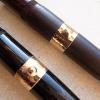
Conid Kingsize Celluloid Bulkfiller In Flanders Field Le, Titan Ef
mongrelnomad posted a topic in Fountain Pen Reviews
Family Portrait It is no secret that I have been a fan and supporter of Conid’s Bulkfiller since the very beginning. When news began to filter through FPN that a new filling mechanism that would provide over double the capacity of its competitors was being designed by one of our own, I felt it was my obligation as an avid user to support the fledgling endeavour. Nearly two and a half years ago, I received my FPR (First Production Run) demonstrator Bulkfiller; a year later I added a second: a black delrin streamline. Then came word that a new model was being developed - an ebonite oversize - and that a special edition in vintage Tibaldi Imperial Celluloid was planned in very limited numbers. I immediately contacted Werner and, a few months later, the pen arrived in Israel. That beautiful celluloid... If I have previously had one criticism of my Bulkfillers, it is that the choice of materials never quite lived up to the unique promise of the pen itself. Although my other Bulkfillers are attractive in a simple, Bauhaus, manner, the clear acrylic and delrin lack that pizzazz that infects so many Japanese and Italian pens. Both are fantastically functional (the delrin especially), but they are pens you respect, rather than love. Not so the Flanders LE. The kingsize itself is quite a departure from the established Conid norm: gone are the ruler-straight lines, the slightly extreme length, the twin washers to securely hold the cap when posted. Instead, it is almost sensual, its slightly tapering cap and barrel expertly polished to a flawless sheen to best display the electric blue veins rippling through the celluloid. It has transformed the Bulkfiller into a truly covetable item, and I look forward to future offerings straying from the traditional black. Hand engraved... And, true to Conid’s manner, the machining is flawless. I have never come across any pen by any manufacturer as well put together as a factory-fresh Bulkfiller. There is absolutely no play in the parts, and everything is designed to last forever while being easily user-disassembled for service and cleaning. It is obvious that Francis, the pen’s designer, is as involved in manufacturing as design, because the intelligence of the engineering solutions, and the attention to detail, is astonishing. Nowhere is this more clearly visible than in the clip: produced from a single solid block of titanium, it no doubt cost a fortune to develop and manufacture, and will survive a nuclear winter. That clip: precision engineering, like everything else... Though it is invisible in this specific model, the mechanism is a creation of equal beauty. I remember when my first Bulkfiller arrived, I thought that perhaps it was an unnecessary over-complication. I could not have been more wrong. Unscrew the blind cap, pull out the rod, rotate left to lock, push in, pull out, rotate right to unlock, push in the rod, close blind cap. Done. Now, after two years of use, I can fill any of these pens blind, in an instant, and with clean hands. Francis’s ingenious bend in the titanium rod ensures that I have never suffered from those wandering air-bubbles that frequently reek havoc with my Pilot 823 and Onotos. The dual reservoir also allows me to feed or drain the nib and feed of ink at will (by opening the blind cap and pointing the nib either up or down), meaning that I have never ever suffered an explosion, leak, or inky fingers with any of my Conid pens even after dozens of flights and thousands of miles travelled. All this with over 2ml of ink capacity in even the smallest model - a monstrous 3ml in this kingsize model. The blind cap. The only criticism I have of this pen is the nib. The EF size 6 titanium nib in my delrin streamline (produced by Bock and user replaceable) is one of my best writers: not too wet, not too dry, smooth as silk. So of course I had to order the same in size 8 for this Kingsize. Unfortunately, lightning doesn't strike twice: it is not as much to my liking, being a bit too wet and a little rough. The nibs are user-replaceable and can be purchased in ss, gold or titanium (the last two only for the Kingsize). Note the empty second reservoir. The ebonite feed. No doubt as soon as I have published this review, Francis and/or Werner will contact me to ask why I haven’t notified them, and will offer an instant and completely satisfactory solution (this is the kind of incredible service you get from Conid included in the price of admission), but I wanted to give a fair view of what to expect out of the box. It is, and remains, my only criticism of this most incredible pen. Writing sample on Rhodia with Montblanc Lavender ink. Note the full reservoir (without refilling the pen). No, I lie. I have two criticisms, though the second is not reeeeallly directly relevant... Too much... I usually don’t mention packaging much. I am a user, not a collector, and so feel that boxes etc are to pens what cellophane and plastic are to fruit: an unnecessary waste. I understand that this pen is a labour of love, designed in Belgium to honour the millions lost as WWI ravaged Flanders, but despite the effort, care and attention to detail, all the dog tags, the USB sticks and the unique box (no doubt costing Conid an arm and a leg) are completely superfluous. Less is more, and I feel that pen would have been as impressive (perhaps more) with a simple wooden box (see Onoto/Nakaya/MontblancPOA), perhaps with an included poppy. But, as I said and as you know, packaging means nothing. Cost, however, does. I paid comfortably double the price of a ‘standard’ ebonite kingsize for this LE. Some of that is no doubt down to the material, some to the (unnecessary) packaging, and some (hopefully) is easy revenue towards the development of the cheaper and more mass-produced Bulkfillers. While I consider the standard ebonite Kingsize a well-priced pen (and would urge anyone in the market for a Montblanc 149 or Pelikan M1000 to give one a chance), this LE was a pure, glorious indulgence, one for which I have no regrets. I would do it again in a heartbeat. I have been travelling heavily recently, and it is no coincidence that my Visconti three pen case has been filled with my three Conids. Since the Bulkfiller’s inception, they have always been the most functional pens you can buy. However, with the LE's celluloid and the Kingsize's more elegant design, the Bulkfiller is a pen you can now buy with your heart as much as your head. Does that make it the best pen in the real-world? There’s a pretty good argument to be made for that…- 20 replies
-
- conid
- bulkfiller
-
(and 2 more)
Tagged with:
-
I’ve been eyeing the Conid Bulkfiller for a while now. After reading review after review about how great these pens are, I caved and decided to order one. I emailed back and forth with Werner for a while and expressed my desire for a Bulkfiller with some color. He told me that he had a piece of orange ebonite that could be used for a Regular sized Bulkfiller. Perfect, I love orange and I wanted the Regular Bulkfiller anyway. I placed my order and waited (im)patiently for about 3 months. When the pen arrived, I opened the box to find a lovely aluminum box, which opens on a side hinge to reveal the certificate of authenticity (etched in metal), polishing cloth, user guide, and contact information. Under all of that is the main attraction: the pen. http://s32.postimg.org/rep51ms1h/Screen_Shot_2016_05_13_at_3_04_46_PM.png I am thrilled with the appearance of this pen. The color of the orange ebonite is even more pleasing than I had hoped. It immediately reminded me of the vintage Parker “Big Red” Duofolds that I’ve seen. http://s32.postimg.org/5gew2m8vp/Screen_Shot_2016_05_13_at_3_03_04_PM.png The size and balance is perfect for me. It’s the most comfortable pen I own. Light, but not cheap feeling. The grip section is long, with an hourglass shape that cinches in at just the right point. This pen gets top marks for comfort. http://s32.postimg.org/5huccixyt/Screen_Shot_2016_05_13_at_3_03_40_PM.png I went with a fine titanium nib. It performs well with no problems. The flow is reliable, yet not too wet. Most of my other pens are pretty wet writers, but this one is a tad drier. It writes every time it touches paper and never skips. One thing I did notice is that the fins on the feed are almost always saturated with ink. This doesn’t effect the performance (it doesn’t drip or leak), but I haven’t seen that with any of my other pens. There’s not much to say about the filling system that hasn’t been said before. It works great, and it holds a ridiculous amount of ink. I really like the two reservoir system that can be sealed off for travel. So far, I'm really happy with this pen and I'm looking forward to using it regularly for a long time to come.
- 23 replies
-
- conid
- bulkfiller
-
(and 1 more)
Tagged with:
-
With the recent rave reviews of the Conid Bulkfiller, I've decided to join in the fray. So which one should I start with, the Regular size or Minimalistica? It seems to me that the sizes and feel are very similar. I currently use all sizes of pens with all types of nibs...but prefer the M800 and 146, for size. It also seems that the choice comes down to a slip cap vs. screw on...and flat black vs. demonstrator. On either pen I'd begin with a titanium medium, and just see where that might take me. I'd appreciate any advice or thoughts. D
- 44 replies
-
- conid
- bulkfiller
-
(and 1 more)
Tagged with:

